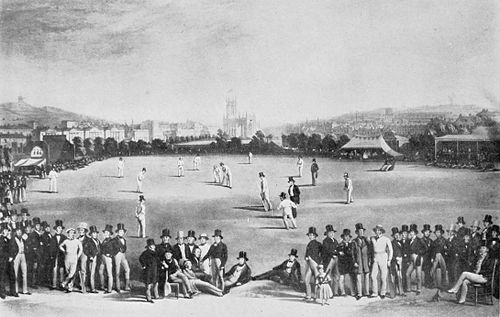Cricket grew out of the many stick-andball games played in England 500 years ago. The word ‘bat’ is an old English word that simply means stick or club. By the seventeenth century, cricket had evolved enough to be recognisable as a distinct game. Till the middle of the eighteenth century, bats were roughly the same shape as hockey sticks, curving outwards at the bottom. There was a simple reason for this: the ball was bowled underarm, along the ground and the curve at the end of the bat gave the batsman the best chance of making contact.
One of the peculiarities of cricket is that a Test match can go on for five days and still end in a draw. No other modern team sport takes even half as much time to complete. A football match is generally over in an hour-and-a-half. Even baseball completes nine innings in less than half the time that it takes to play a limited-overs match, the shortened version of modern cricket!
Another curious characteristic of cricket is that
the length of the pitch is specified—22 yards—
but the size or shape of the ground is not. Most
other team sports such as hockey and football
lay down the dimensions of the playing area.
Cricket does not. Grounds can be oval like the
Adelaide Oval or nearly circular, like Chepauk in
Chennai. A six at the Melbourne Cricket Ground
needs to clear much more ground than it does at
Feroz Shah Kotla in Delhi.
There’s a historical reason behind both these
oddities. Cricket was the earliest modern team
sport to be codified. The first written ‘Laws of
Cricket’ were drawn up in 1744.
They stated, “the principals shall choose from amongst the gentlemen present two umpires who shall absolutely decide all disputes. The stumps must be 22 inches high and the bail across them six inches. The ball must be between five and six ounces, and the two sets of stumps 22 yards apart”. The world’s first cricket club was formed in Hambledon in the1760s and the Marylebone Cricket Club (MCC) was founded in 1787. During the 1760s and 1770s it became common to pitch the ball through the air rather than roll it along the ground.
This change gave bowlers the options of length, deception through the air, plus increased pace. It also opened new possibilities for spin and swing. In response, batsmen had to master timing and shot selection. One immediate result was the replacement of the curved bat with the straight one. The weight of the ball was limited to between 5½ to 5¾ ounces, and the width of the bat to four inches. In 1774, the first leg-before law was published. Also around this time, a third stump became common. By 1780, three days had become the length of a major match, and this year also saw the creation of the first six-seam cricket ball.
If you look at the game’s equipment, you can see how cricket both changed with changing times and yet fundamentally remained true to its origins in rural England. Cricket’s most important tools are all made of natural, preindustrial materials. The bat is made with leather, twine and cork. Even today both bat and ball are handmade, not industrially manufactured. The material of the bat changed slightly over time. Once it was cut out of a single piece of wood. Now it consists of two pieces, the blade which is made out of the wood of the willow tree and the handle which is made out of cane that became available as European colonialists and trading companies established themselves in Asia.
Unlike golf and tennis, cricket has refused to remake its tools with industrial or man-made materials: plastic, fibreglass and metal have been firmly rejected. But in the matter of protective equipment, cricket has been influenced by technological change. The invention of vulcanised rubber led to the introduction of pads in 1848 and protective gloves soon afterwards, and the modern game would be unimaginable without helmets made out of metal and synthetic lightweight materials.
Click here to continue read : the-story-of-cricket-part-2





0 Comments